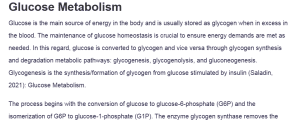Glucose Metabolism
Glucose is the main source of energy in the body and is usually stored as glycogen when in excess in the blood. The maintenance of glucose homeostasis is crucial to ensure energy demands are met as needed. In this regard, glucose is converted to glycogen and vice versa through glycogen synthesis and degradation metabolic pathways: glycogenesis, glycogenolysis, and gluconeogenesis. Glycogenesis is the synthesis/formation of glycogen from glucose stimulated by insulin (Saladin, 2021): Glucose Metabolism.
The process begins with the conversion of glucose to glucose-6-phosphate (G6P) and the isomerization of G6P to glucose-1-phosphate (G1P). The enzyme glycogen synthase removes the phosphate group from G1P and uses the left glucose unit to gradually create a chain of glucose polymer, that is, glycogen.
Glycogenolysis is essentially a reverse process of glycogenesis; it is the hydrolysis or breakdown of glycogen to release glucose, which is activated by epinephrine and glucagon hormones. Here, the enzyme glycogen phosphorylase phosphorylates a glucose residue and removes it from a glycogen molecule in the form of G1P. G1P is then isomerized to G6P and proceeds to undergo glycolysis (Saladin, 2021). The enzyme glucose-6-phosphatase converts G6P to free glucose by removing the phosphate group.
Further, gluconeogenesis is a process that synthesizes glucose from non-carbohydrate sources like lactate, glycerol, pyruvate, and amino acids (Jeroundi et al., 2024; Melkonian et al., 2023). Notably, the maintenance of glucose homeostasis also relies on another metabolic process called lipogenesis. Lipogenesis is the synthesis of fats. It utilizes excess glycerol and acetyl coenzyme A (acetyl-CoA), particularly from glycolysis. Acetyl-CoA is converted to fatty acids, which, together with glycerol, form subsequent triglycerides that are stored in the adipose tissue or converted to other lipids (Saladin, 2021).
These metabolic processes occur in response to the concentration of blood sugar. Shortly after taking a carbohydrate-rich meal, the blood sugar level would be high. As such, the body would need to convert excess glucose to compounds suitable for storage to maintain glucose homeostasis; therefore, likely processes that would occur are glycogenesis and lipogenesis.
Conversely, the blood sugar level would be low just before waking up in the morning when one has not eaten. Consequently, low blood sugar concentration would trigger processes that synthesize glucose—namely, glycogenolysis and gluconeogenesis.
References
Jeroundi, N., Roy, C., Basset, L., Pignon, P., Preisser, L., Blanchard, S., Bocca, C., Abadie, C., Lalande, J., Gueguen, N., Mabilleau, G., Lenaers, G., Moreau, A., Copin, M., Tcherkez, G., Delneste, Y., Couez, D., & Jeannin, P. (2024). Glycogenesis and glyconeogenesis from glutamine, lactate and glycerol support human macrophage functions. EMBO Reports. https://doi.org/10.1038/s44319-024-00278-4
Melkonian, E. A., Asuka, E., & Schury, M. P. (2023, November 13). Physiology, gluconeogenesis. StatPearls – NCBI Bookshelf. https://www.ncbi.nlm.nih.gov/books/NBK541119/
Saladin, K. (2021). Anatomy and physiology: The unity of form and function (9th ed.). McGraw-Hill Education.
ORDER A PLAGIARISM-FREE PAPER HERE
We’ll write everything from scratch
Question 
Initial Post Instructions
- A nutrient is a substance in food that is used by the body to promote normal growth, maintenance, and repair. During metabolism, substances inside body cells are constantly built up or broken down. Let’s start this week’s discussion with the definition and comparison of glycogenesis, glycogenolysis, gluconeogenesis, and lipogenesis. Which is (are) likely to be occurring (1) shortly after a carbohydrate-rich meal and (2) just before waking up in the morning?
- Resource:
